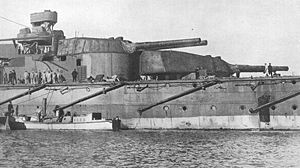BL 13.5 inch Mk V naval gun
| BL 13.5 inch Mk V gun | |
|---|---|

Rear turrets of HMS Thunderer
|
|
| Type | Naval gun |
| Place of origin | United Kingdom |
| Service history | |
| In service | 1912 - 1940s (as railway gun) |
| Used by | United Kingdom |
| Wars |
World War I World War II |
| Production history | |
| Designer | Vickers |
| Designed | 1909 |
| Variants | Mk V(L) Mk V(H) Mk VI |
| Specifications | |
| Barrel length | Bore 50 ft 6 in (15.392 m) (45 cal) |
|
|
|
| Shell | H: 1,400 lb (635.03 kg) L: 1,250 lb (566.99 kg) HE, AP |
| Calibre | 13.5-inch (342.9 mm) |
| Elevation | Naval: 0° - 20° Railway: 0° - 40° |
| Muzzle velocity | H: 2,491 ft/s (759 m/s) L: 2,582 ft/s (787 m/s) |
| Maximum firing range | H: 23,740 yards (21,710 m) at 20° L: 23,820 yards (21,780 m) at 20° H: 40,600 yards (37,120 m) at 40° (World War II railway gun, with Super Charge) |
The BL 13.5 inch Mk V gun was a British heavy naval gun, introduced in 1912 as the main armament for the new super-dreadnought battleships of the Orion class. The calibre was 13.5 inches (343 mm) and the barrels were 45 calibres long i.e. 607.5 inches (15.43 m). The guns were greatly superior and unrelated to the earlier 13.5-inch (30-calibre) Mk I to Mk IV guns used on the Admiral, Trafalgar and Royal Sovereign classes completed between 1888 and 1896.
The gun was developed in response to the relative failure of the British high-velocity 12-inch Mk XI and XII guns. Unlike Germany, which developed and deployed successful high-velocity 12-inch guns, Britain in this case switched to guns firing larger and heavier shells at lower velocity which could achieve similar performance in range and armour penetration but could deliver a heavier explosive charge on impact.
The gun was wire-wound and weighed approximately 168,000 lb (76 tonnes) (excluding the breech), and in its original form fired a 1,250 lb (567 kg) armour-piercing capped (APC) or high-explosive (HE) round a distance of 23,800 yards (21,800 m) at a 20-degree elevation.
Due to the excellent characteristics of the gun, it was decided to increase the weight of shell to 1,400 lb (635 kg), with an increased firing charge to achieve about the same range. The gun firing the lighter shell was designated Mark V(L) (for "light") by the Royal Navy, and the 1,400 lb version Mark V(H) (for "heavy"). A very similar 1,400 lb gun, designed for the Ottoman battleship Reşadiye, received the designation Mark VI when the ship was requisitioned by the British government after the outbreak of the First World War, eventually being commissioned as HMS Erin.
...
Wikipedia
